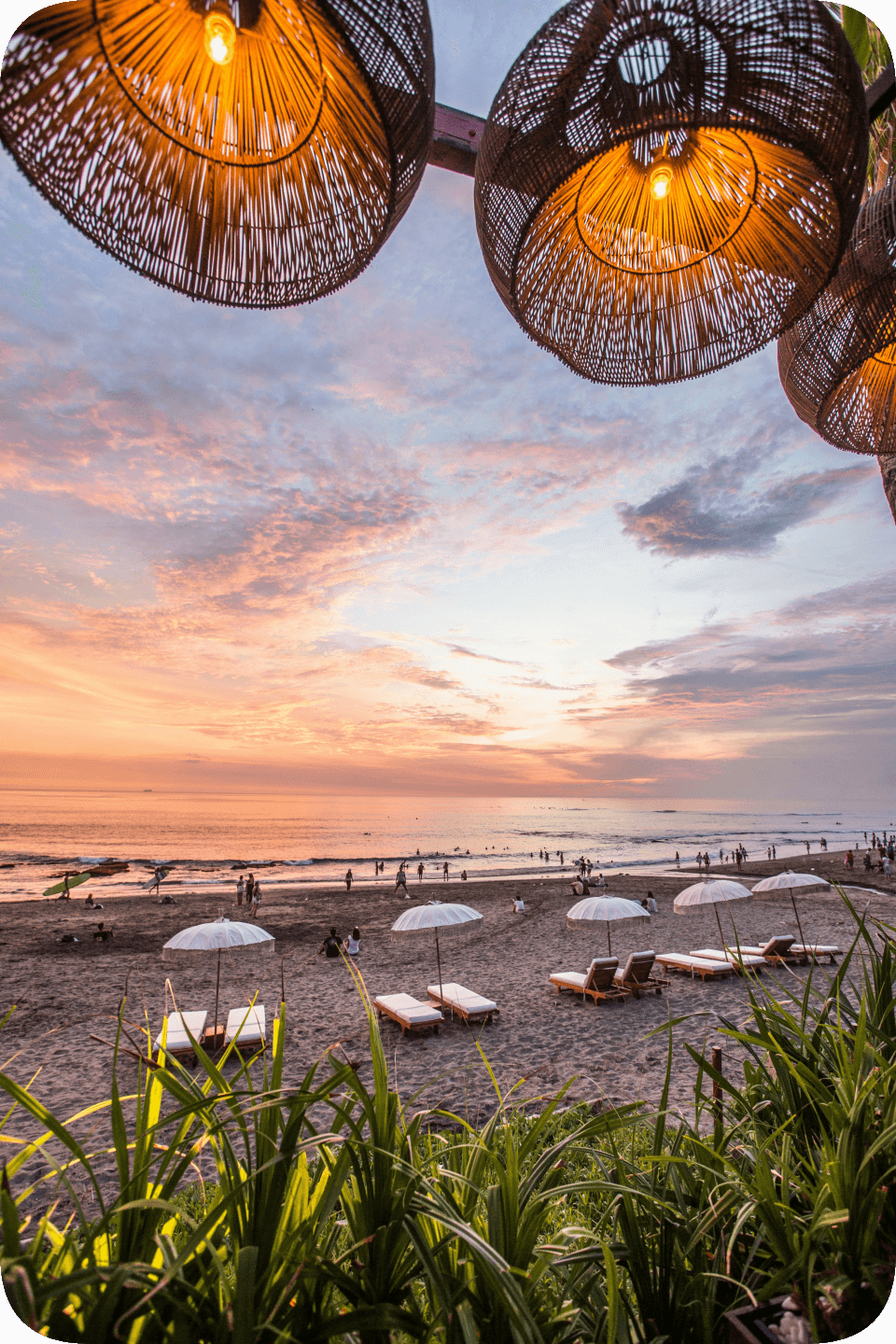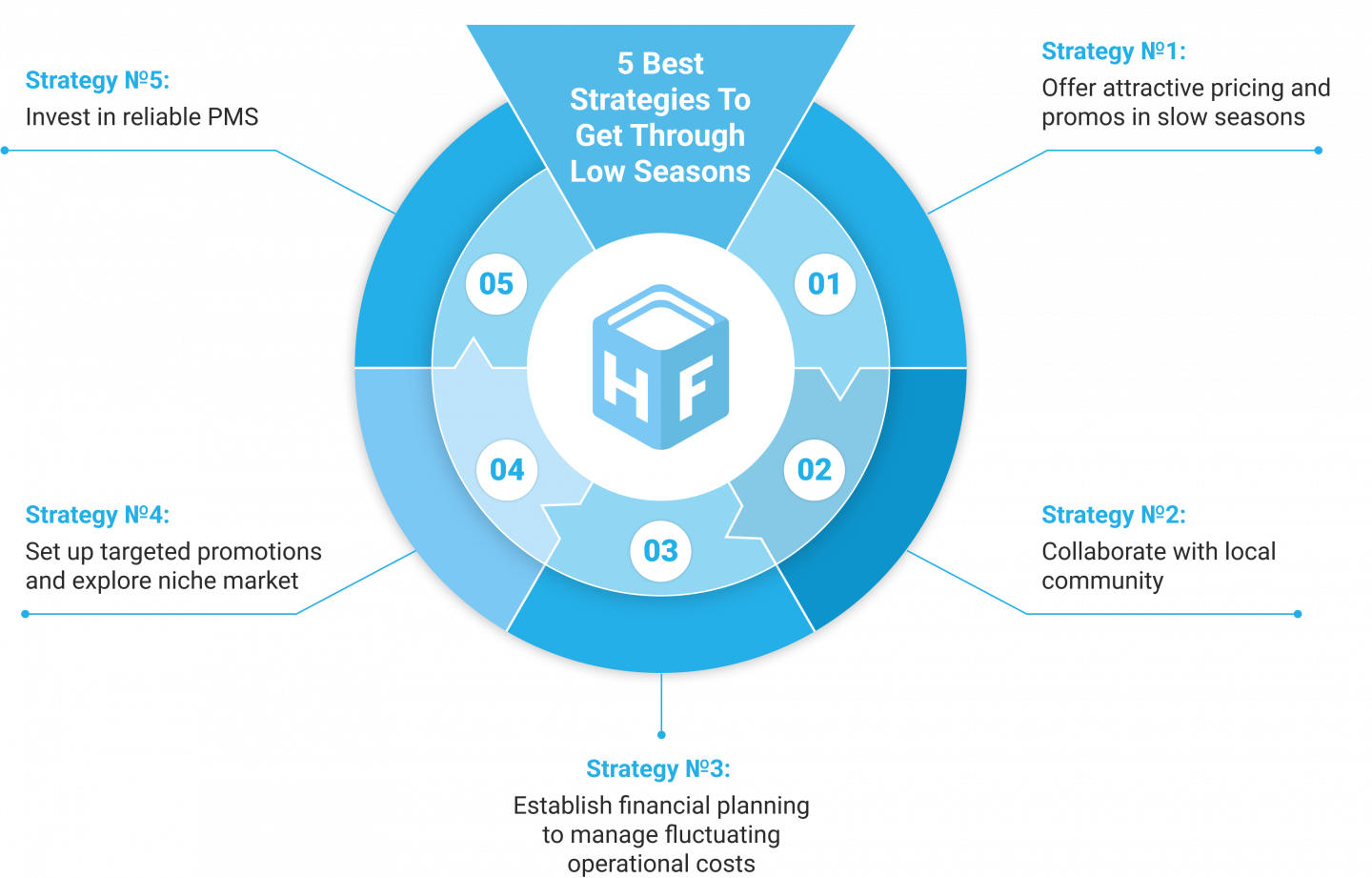Navigating through low seasons always presents challenges that hoteliers must confront head-on. Yet, while they work on minimizing the effects of quieter times, it's crucial to remember that busy periods also require attention.
All in all, the success of the hotel business depends on consistency, and striking the balance in strategies for high and low seasons is your recipe for a profitable year. How to achieve this perfect balance? The answer lies in taking a holistic approach that considers the whole picture.
What are the low and high seasons in hotels?
Let’s start from the basics. Every year, hotels go through two types of seasons.
“High” or “peak” seasons are characterized by high demand, increased occupancy, and higher average daily rates (ADRs). It’s when your hotel is buzzing with activity, rooms booked to the brim, and a sense of excitement is lingering in the air.

During these peaks, your hotel can operate at or near full capacity, creating an opportune moment to set higher room rates. Why? Because the demand surpasses the supply, and guests are willing to pay a premium for a coveted stay.
Some of the things that may contribute to high season in your hotel are:
- ● Popular travel seasons
- ● Holidays
- ● Festivals
- ● Local events
- ● Conferences and business meetings
- ● Cultural or religious events
- ● Social media trends
“Low” or “off-peak” seasons are quite the opposite, bringing lower demand, higher competition, and often the lowering of your rates to maintain decent levels of occupancy. While high seasons make hoteliers thrive, low seasons bring many challenges to address.
You may have noticed that every year, the occupancy rate varies dramatically under the pressure of seasonality. As a true performance indicator, it must be closely monitored to discover the high and low season periods specific to your establishment.
Identifying the unique pattern of tourism seasonality typical for your business can help you find out the factors that contribute to it and make a plan to fix the situation.
For the majority of hotels, the high season lasts from June to August, and the low season is from November to March. But it’s important to mention that every hospitality business has its specifics, and its own peaks and lows.
It largely depends on the type of property, country, and local weather conditions. For instance, the owners of chalets near ski resorts expect winter to be much more lucrative than the owners of beach hotels.
All these seasonal fluctuations impact revenues, but a proactive hotelier can turn this challenge into an opportunity by establishing long-term strategies, mitigating the consequences of seasonality.
What challenges do hotels face during the low season?
As seasons change and travelers’ preferences shift, hotels face common issues—especially in the low season. These quieter periods present specific challenges that smart hotel managers need to tackle.

Decreased occupancy rates
One of the key challenges during the off-season is the decline in occupancy rates. With fewer travelers seeking accommodation, hotels face the struggle of filling their rooms. This results in empty spaces and underutilized resources including staff, utilities, and amenities.
Cash flow management issues
Correct cash flow management becomes your primary task during the slow times. You need to balance expenses carefully with incoming revenue. The tricky part is to ensure that you cover all operational costs, maintaining an ability to invest in necessary upgrades.
Instability in income and ROI
Then, reduced occupancy naturally translates into lower revenue. Hoteliers must navigate through financial fluctuations, prioritizing budget management and exploring creative revenue streams to offset the income dip.
Cost of seasonal recruiting
Maintaining an optimal staff-to-guest ratio poses another challenge. On the one hand, you can reduce staff levels to align with the decreased demand. On the other hand, you may choose to retain staff to ensure quality service. Mind that the latter may lead to increased labor costs relative to revenue.
Low results in marketing and visibility
Promoting a destination or hotel during the low season is no simple feat. Your marketing efforts may not yield the same returns as during peak periods. Hotels need to use new and targeted strategies to maintain visibility and attract potential guests.
5 best strategies to get through low seasons
Luckily, seasonality is related to consistent and established patterns rather than sporadic ones. It provides a level of predictability that enables managers to forecast its effects and implement various strategies to counter any negative impacts.

Strategy №1: Offer attractive pricing and promos in slow seasons
To maintain financial stability year-round, it's important to check how many sales you make each month. And to boost these during quieter times, it's a good idea to offer attractive prices and deals.
Make things easy for guests by putting together attractive packages that include meals, transport, and activities. This not only saves them hassle but also adds value to their stay.
- ● Promote group booking offers catering to families, corporate events, or special occasions
- ● Offer complementary services or create themed packages (e.g., “Adventure Getaway” with guided hikes)
- ● Design off-season holiday packages
Strategy №2: Collaborate with local community
Working with neighboring businesses can mutually benefit both parties during slow periods. Provide your guests with extra perks such as attraction tickets, restaurant discounts, or wellness packages to incentivize guests to book a stay.
Partnerships with local attractions, spas, and other establishments allow you to both put your property on the market and elevate the guest experience. Make sure to advertise these offers through the right channels to increase visibility and draw in more guests.
- ● Partner with tour operators to sell your rooms, products, or services
- ● Offer your hotel as a venue for local events to fill your rooms and generate revenue through F&B
- ● Collaborate with local businesses and attract new marketing resources
Strategy №3: Establish financial planning to manage fluctuating operational costs
In your budgeting approach, divide expenses into different categories like fixed costs, variable costs, and operational expenses. Use realistic estimates for both revenue and expenses, considering past data and industry standards.
Establish and monitor key financial indicators like revenue per available room (RevPAR), average daily rate (ADR), and occupancy rate. It's also important to set aside emergency funds and build strong relationships with financial partners to weather any challenges and support future growth.
- ● Identify fixed and variable expenses, ensuring stable coverage for key costs, such as personnel
- ● Keep a minimum of two months' worth of business expenses saved up
- ● Save during high seasons to prepare for thin times
Strategy №4: Set up targeted promotions and explore niche market
Consider exploring niche markets that might be interested in long-term stay packages. For instance, retirees seeking extended stays to immerse themselves in a new community or young digital nomads who want a change of scenery.
Get creative during low seasons by offering exclusive services such as hotel team-building retreats, pet-friendly accommodations, or complimentary stays for children.
- ● Explore niche OTAs to diversify your distribution channels
- ● Craft long-term stay packages that cater to new target groups
- ● Introduce low-season specials, such as wellness or business retreats, etc.
Strategy №5: Invest in reliable PMS
To successfully handle seasonal fluctuations, hotels should use advanced technology that can support them in tough times. Automated property management system like HotelFriend can efficiently process large datasets, offering valuable historical data analysis and monitoring vital metrics like ADR, RevPar, and Occupancy.
They also ensure pricing and inventory remain consistent across all distribution channels. All this enables hotels to make prompt adjustments, refine pricing strategies, and remain competitive in a constantly evolving market.
- ● Provide flexible cancellation policies to guests
- ● Tap into revenue management and forecasting
- ● Update pricing and inventory across OTAs in real-time
5 best strategies for optimizing your high seasons
During peak seasons, hotels may encounter challenges of some other nature. First, it’s effective management of room capacity to ensure all guests are accommodated without having to turn away potential bookings.
Second, striking the right balance in pricing becomes tricky; high rates may deter guests while overly discounted prices can result in revenue loss. Staffing resources are often stretched thin due to increased workload, and prioritizing guest satisfaction in crowded facilities becomes paramount.
To navigate through this challenging yet opportunistic period, here is what you can do.

Strategy №1: Embrace staffing flexibility and training for peak times
Using a flexible approach to staffing means you can adjust your workforce when demand goes up or down. This helps your business react quickly to changes, giving you an edge over competitors who stick to traditional staffing.
To figure out how many staff you need, you can look at past years' data or see what your competitors are doing. Remember to hire extra staff before the busy season starts so they have time to learn the ropes. Good staff training prevents chaos, keeps turnover low, maintains hygiene standards, and keeps customers happy.
Strategy №2: Upsell your guests and cross-sell services
Train your staff to suggest upgrades or extra services to guests to boost income all year round. Offer perks in loyalty programs to keep guests coming back for new experiences. Promote these deals on your website and remind guests staying with you about them. By doing this effectively, you can make more money per guest without needing to sell more rooms, which is beneficial in any season.
Strategy №3: Improve your online visibility
Make sure more people can find your hotel online by improving your website, staying active on social media, and listing your hotel on top OTAs. Encourage guests to book directly through your website by offering them special benefits like cheaper prices or free upgrades.
Another good idea is to make a Google My Business account if you haven't already. Since Google is the biggest search engine, showing your hotel among the first results can bring in a host of customers, especially if you're trying to attract local guests. To learn more about Google My Business, check out our article on Google Hotels.
Strategy №4: Make it easy to book via mobile phones
As reported by TravelPerk in 2023, nearly half of travelers used their mobile phones for various travel-related activities. About 48% utilized their devices for researching destinations, 47% for comparing transportation and accommodation costs, and 40% for booking flights and hotels.
It's important to note that many mobile bookings are made for last-minute or next-day stays. This means you can attract more guests by targeting this group. Make sure your website is mobile-friendly to provide a smooth experience for smartphone users.
Strategy №5: Tweak your minimum and maximum LOS
By setting rules for Length of stay (LOS), you can increase your earnings, especially during busy times. When you expect a busy period followed by a slower one, you can require guests to stay a minimum number of nights. This helps fill up rooms during the quieter times after the rush.
Implementing a maximum length of stay is beneficial when you expect high demand at premium rates. Avoid accepting reservations at discounted rates for multiple nights that extend into this period. Guests wanting to stay longer can be charged the full rate for additional nights beyond the maximum stay period.
Balancing all strategies for year-round success
When hoteliers strategically plan for low and high seasons, they should not just mitigate the challenges posed by seasonality but also capitalize on opportunities to maximize revenue and guest satisfaction throughout the year.
Strategies adopted during one season can significantly impact the other, highlighting the interconnectedness and necessity of a holistic approach. For instance, marketing efforts deployed during low seasons play a crucial role in shaping guest perceptions and driving demand during high seasons.
Similarly, the quality of service provided during peak periods directly impacts guest perceptions and satisfaction levels, influencing repeat business and referrals during subsequent low seasons. That’s just the way it works.
Conclusion
In navigating the challenges of seasonality, we understand that there is no one-size-fits-all solution applicable to every hotel. Nevertheless, as our final recommendation, consider the following principles that can guide you even closer to success:
- ● Evaluate your company's performance annually to identify patterns of seasonality
- ● Take stock of where your business is now and where it could get to in the future
- ● Prepare to the low times in your busy season
- ● Always be ready for the unexpected
- ● Get creative with packages and partnerships
- ● Align your revenue goals with marketing efforts
- ● Leverage the power of reliable PMS
Putting these strategies into action, you'll boost your hotel's performance year-round. Don't wait—give them a closer look while preparing for your new low or high season.






